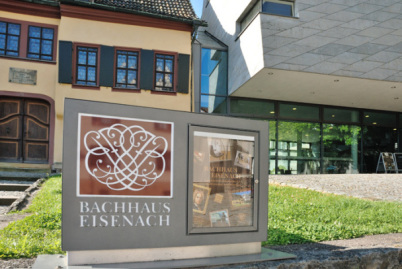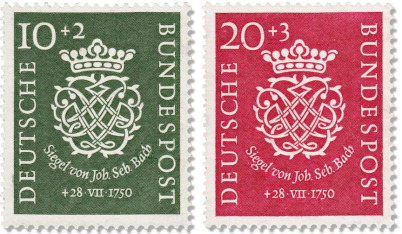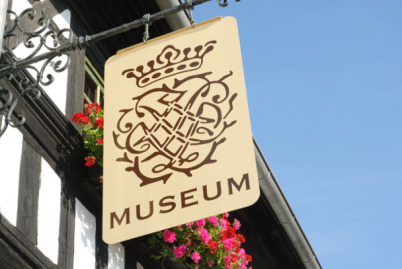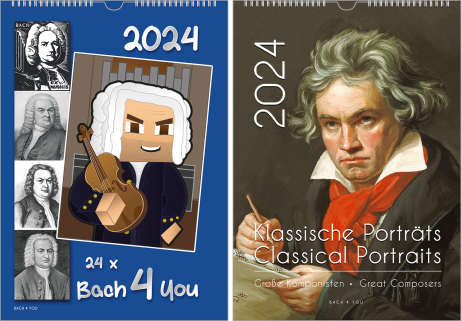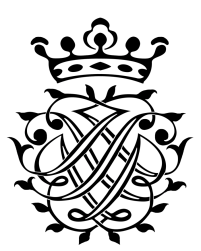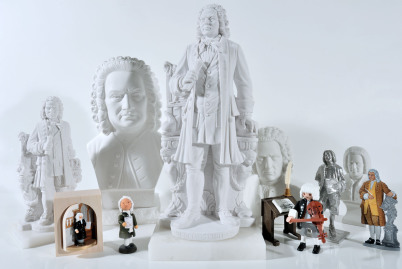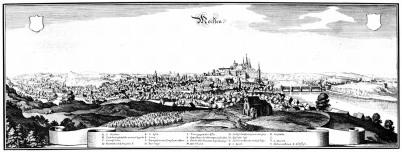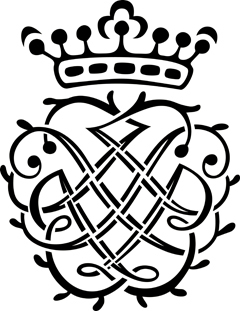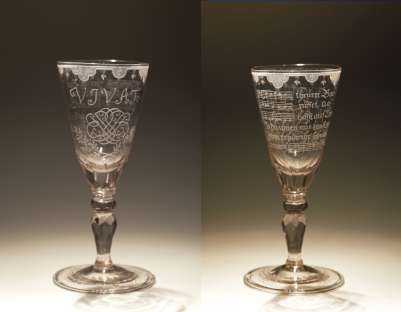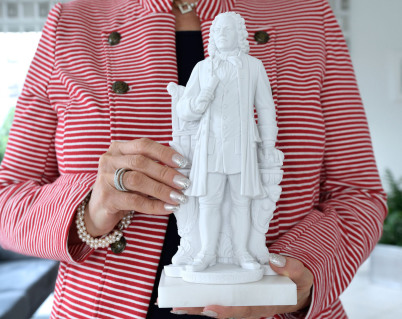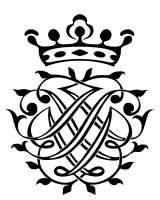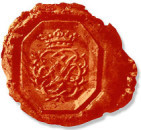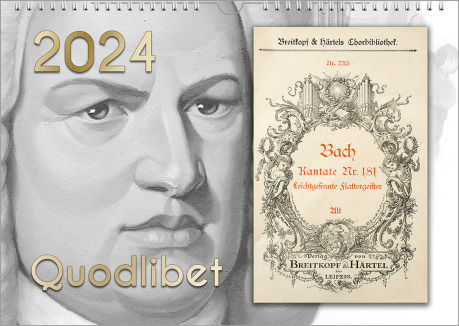Bach FAQ 106
Is There One Bach Seal or Two Bach Seals? One Bach Monogram or Two Bach Monograms? Or Maybe Even Some More?
The 100 most important Bach FAQ.
To the point: there is not only one up-to-date Bach seal. Or, if you want that ... Bach Crest, Bach Monogram, Bach Sign, Bach Motif.
For those in a hurry: The current and "correct" graphic Bach Seal since 2009 has exactly five prongs or cones in the crown. For over 250 years until 2009, there were seven prongs. This is how it was interpreted, what was seen on the ancient documents as Bach's seal depicted in the sealing wax. In addition, since 2009 there is the thousand times unknown original Bach Monogram in the best quality. It was "found" in this year. And who is interested, whether there are now even three Bach Seals, or four or meanwhile eight ... or just "only" two ... can find out with very little of my exciting entertainment in the following chapters. Have fun with it.
By the way, it is also interesting to note that if you Google "Bach Seal" on the internet and click on "images", you will find the "wrong" Bach Seal twelve times among the first fifteen images. The "correct" one, more precisely one of the two correct Bach Seals, however, is included only three times. But at least the today correct one is on place 1, thus ... the one of the two current ones. But that ... changes day by day.
Exciting, thrilling and right: The Bach Seal / Bach monogram in front of the Bachhaus Eisenach, Thuringia, Germany. Without crown. And without the "stuff around it". But with 14 spots. 14 ... a "Bach number". Is this then really "correct" after all? Yes, it is. But please read more about this below.
In 1950, the official Bach Seal / Bach Monogram was still the one with the crown and its seven prongs or cones. At that time, it had already been that for around 200 years ... almost from the death of the famous composer.
One More Section, Then It Starts ... To Bach Seal / Bach Monogram 1, to Bach Seal 2 and to Bach Seal 3, 4, 5, 6 and Finally to Bach Seal 7 as Well as 8
. . .
Particularly in Bach science, individual areas have their own history. And because this musician – once again – is a little complicated in every respect, the same is true for the story around the Bach seal. But before I introduce you to this history of the Bach seal, it should be mentioned that the most famous Bach scientist and author Prof. Christoph Wolff assumes that the research around this expert will probably never be completed. In the last 250 years, of course, new pieces of music by the Royal Court Composer have appeared. It is unusual, however, that they also argued about it and even agreed in some cases that some music pieces haven't been composed by the Thomaskantor, although this was previously considered as safe. Whether Bach has copied, that is to say, copied – even mainly from his own works – though chiefly his own – is a funny subject to argue: I keep out of it.
For around 250 years it was also assumed that the Bachhaus in Eisenach was the birthplace of Johann Sebastian – but it was not. The "origin of the musical-Bach family", a compilation of 53 members of the clan, collected by himself: it is invaluable, but it is not a family tree.
The origin of the family of musicians: yes, Veit came from Hungary. But he came back from Hungary: a major difference. The Bach son with the hat: for decades they thought it was Friedemann. But he is not. Since one of the families of musicians has put a "cuckoo egg" in form of a painting in the "historical nest". The composer from Eisenach, painted by the painters Ihle and Rentsch: famous paintings. But the Thomaskantor did not look like this at all.
The beer cantata, which he was supposed to have composed. There is such a cantata, but it is not composed by Johann Sebastian. The re-enactment of the St. Matthew Passion: it was the decisive event for the beginning of popularity after exactly 100 years until today. On the day, for it was Good Friday and most likely even the time of the day was the same. Then science found out that the St. Matthew Passion was premiered a year earlier than expected. Now, this performance dates 101 years later: this is not such a nice round date anymore. Unfortunately.
You see, around the musician from Thuringia there is not just the one correct history. No, there are often stories about coming with the story. And the story around the Bach seal is particularly exciting and here again rewritten for you. And as FAQ 106 it is now never "lost". I myself heard of it in the Bachhaus for the first time. However, because I was just looking for something written, I asked the Bach Archive to help me. I have received a lot of support from there for many years, that is to say, since my project has started. And also in the case of the Bach seal once again. I took the content from the annual report of this institution of 2009, but then, in addition, especially from the 2009 yearbook. To the author of the detailed text in the yearbook, Mr. Ulf Wellner, a cordial thanks for his research and the report, to the Bach Archive, a cordial thanks for the mailing.
The sign at the Bach-Stammhaus in Wechmar: It is the Bachsiegel, which since the time in Köthen was the only correct one. Up to the third millennium today. Only a few years ago it is now different. With only five cones in the crown, instead of seven.
Advertisement
99 Music Calendars, Composers Calendars and Bach Calendars
A Bach Seal of the Past Develops Into the Bach Seal of Today
We know it for a long time: Johann Sebastian designed his seal himself, long before the year 1720. This was the original form of the now known barrack: a simpler mesh of the three letters J + S + B and the same letters Again in the mirror. A few papers. Laurel branches right and left. Finished. In practice, the Kapellmeister used it as a relief on his signet ring and pressed this coat of arms on the hot, still liquid red sealing wax. It is documented in early documents. However, exactly this seal ring and the seal stamps are no longer preserved. But there are them, the footprints on some original documents. Initially, this brook sail had no crown as a third component. Later on. Now it might be assumed that this crown points to the honor which Johann Sebastian, as Royal Polish and Electoral Saxon Court Composer, points out, but, already at his service in Leipzig, she was above the letter, the crown. With the jags. Seven in number. Thus it was identified at least from the historical documents. And the whole thing for 270 years.
The Bach seal: minus two pins, spikes, blips or maybe jags ... the Bach seal from 2009 is thus the official.
Bachs Money Box: Welcome to the "World of Indiana Jones"
Meissen is a good half hour northeast of Dresden and there is the Meissen Cathedral. And what can you find there in 2009? A treasure chest, or something factual a "money box," doubtless – as scientists say – from the Leipzig Thomaskantor. And what do the experts find in the inner cover? The Bachsiegel. And how many cones does the crown have? Five, not seven. The Meissner Domstift left this rarity to the Bach Archive and Museum in Leipzig. As a loan. And there you can admire them today. Mysteriously, the coat of arms or seal gave the experts a long time. It was not clear with either five or seven teeth. Five pegs would have pointed heraldically to a citizen. Whether seven cones, in contrast to a nobleman, refer to the source: But I know where I can find out. On this find in the cathedral at Meißen, the seal was corrected in the logo of the Bach Archive and everywhere in the world the new one with only five teeth was now cool. And so the Bachsiegel has its own history. So the bridge with its seven cones can now be described as "wrong" or even as the right, even before 2009. Or at least the possible and for many the right, just between 1750 and 2009.
The correct Bach Seal – A Hefty Thank You!
Thanks to Ulf Wellner from Lübeck, the author as well as to Dr. Peter Wollny, the publisher of the "Bach-Jahrbücher" (Bach Year Books): the facts are taken from a report in the yearbook 2009. Here on this website, an amazing little story about the history of the music genius is to "drown" the drowning in today more than 53,000 books, reports, dissertations and essays to Johann Sebastian and the musician family. With this site and the hope that you can find them, on the Internet, if you googled.
© Photo/Source/License: By Avda (Own work) [CC BY-SA 3.0], via Wikimedia Commons
The science surrounding the Thomaskantor leads us to Meißen after the death of the genius: 27,000 inhabitants, Saxony, 25 kilometers from Dresden, on the Elbe: here the view of Burgberg, Dom, and Albrechtsburg.
There It Has Been for a Really Long Time: Johann Sebastian Bach's Geldkiste, JSB's Money Box
First of all, it should be clarified that in this context it was not discovered that the Thomaskantor was rich. The so-called "money box" was a chest in which one did not find the composer's money, but a container of iron, which had a baroque paint on the inside of the lid. She, the money box, was already set up in the Museum of the Meissner Dom in the cash register area in the mid-1990s. No one knew what this was about. They are set up, and the crown of the crown with the crown was clearly visible to everyone, thus collecting donations. It was not until 1990 that a visitor to the cathedral noticed that it was the bridge, only with five cones, not seven. Later, it was also noted that the painting dated before 1750, and Siegel and Alter led to the realization that the crate was the property of the composer. As mentioned: the crate. No money in it.
© Photo/Source/License: By Avda (Own work) [CC BY-SA 3.0], via Wikimedia Commons
The Cathedral at Meissen (... behind the castle): Here it stood, the money box, with an open lid and the well-visible barrack. It took about 16 (... or 160) to clarify (internally) years until someone knew that a gem in the history of the musicians' family "stood around" completely unrecognized.
Advertisement
The Bach Figure, the Bach Bust, the Bach Statue
Two Padlocks Plus 11 Bars – What's Coming Now Is Really and Honestly the Truth – No Kidding!
The dimensions of the money box? Height 54 cm, width 69 cm, depth 45 cm. The keyhole on the front: a dummy. But there is also a key. And it fits in a different place. Two padlocks were provided, but none of them were there. And inside: whole eleven ties. And nuts and bolts. The original nuts of that time, which experts recognized by the color above, which is also found in the seal.
Anyone who is reading from you here now needs to know that I do not have a "quark" on this site. In other words, I often do not really know whether I am going to put a little conversation into a "dry piece of matter," or, as in the chapter on the music of Johann Sebastian on the Golden Disk in the space probes Voyager 1 and Voyager 2 , Only or mostly at least a little around. But, this is not the case in this chapter. That I mention it is important, because, in the list of the Johann Sebastian catalogs, a "Putzschranck" is listed under three pieces of furniture and if you were on my website already violently, then it is important now: "... completely without flax".
It took many, many decades until the way of the money box with the Bachsiegel found the way to the Meissner Dom. Here is a view of what the city looked like during the lifetime of the composer.
What is a "Putz Schranck"? For us today a clear thing: there are cleaning agents in it. From master proper to washing machine salt. The word "plaster" can also be used in the context of the word "to clean out", thus "make beautiful" and connect with jewelry "plaster". And jewelry is valuable and fits the "money box" from Meißen outstanding. Probably this box is the "Putz Schranck" mentioned. A researcher with the name Zedler was here the expert and has found it for us interested.
Did the original Bach seal look like this? Certainly not exactly, but the essential is taken into account: just no crown.
What Does the Crown Mean in the Bachsiegel ... the Bach Seal – We May Never Ever Figure that Out for Sure!
1716 dates the first preserved document when the composer "signed" for the first time with a seal. That is to say, that he did it already before, but today there is just no proof of such a document anymore. It's - so to speak our "origin seal", however, that's no official term. This seal has not a crown yet and with that, it is our Bach seal number 3.
And the seal with the seven cones, as one knew it for more than two centuries and until 2009? This can be seen for the first time on a document from the time of Koethen when the composer played at the court of Prince Leopold. It is dated March 15, 1722. It is interesting for those who are "on the hunt" for a reason for the crown, that the Köthener Kapellmeister and music director at that time are still not "Royal Polish and so on ... Farm composer was ". Why, therefore, the crown, can not be so easily fathomed. In summary, it can be said that the seal in the inner lid of the money box looks different in many small details than the seal we know, so different from Bachsiegel 2 and 3, so to speak. These little things made the Bachsiegel in the crate but not to the Bachsiegel No. 5.
Since there is actually still another Bachsiegel, it is therefore together now 5. Whereby the seals 4 and 5 on my home page, which you are reading is not yet mentioned. The fourth, essentially different level is engraved. And on a glass cup, which is today in the Bachhaus in Eisenach. This was discussed very controversially in the 1930s and later in the 1950s. So, among right scientists. Exciting: the letters are swapped: instead of JSB there is SJB. And this also results in a really different bow. Without crown, it is on the glass cup, but the laurel branches right and left, which are thereby. Our quintessential Numero 4.
Surprise, Surprise: the Fourth Bach Seal
© Photo/Source/License: By Bachhaus.Eisenach [CC BY-SA 4.0 ], from Wikimedia Commons
The Glaspokal from the possession of the Thomaskantors with the fourth bank seal. Do you remember the other three? One without crown, one with crown and seven cones. And finally, a crown with five crowns. Correct, or cones. Thanks again to the Bachhaus, which provides such cool photos.
Advertisement
It's Not Whether There Is a Bach Bust, a Bach Figure, a Bach Statue ... It's about Its Beauty, Quality and Uniqueness
Verkaufte Anna Magdalena Johann Sebastian Bachs Schmuck-Kiste?
My very own opinion on this:
It is assumed that this "Putzschranck" between 1936 and 1980 found its way into the cathedral in Meissen. However, the trip which he traveled from Leipzig since the death of the Thomaskantor in 1750 is no longer to be explored. In the inventory catalog of 1750, it is still contained. Whether Anna Magdalena sold him at that time, is also not proven. My personal opinion? Yes, she did. Because Anna Magdalena survived her husband in "relative poverty". The whole ten years. In the first place, therefore, it made no sense to keep a vessel of valuables, if one had none. For she would have sold her first when she was bad. Secondly, this money box, with a sevenfold increase in value relative to the other two furniture, represented a good object to be sold, which made sense in terms of profit in relation to value as a sale. But, as mentioned, this is my personal opinion, so the author of this homepage.
If there is a "right" bridge today, then it is this: three letters JSB plus three letters JSB in mirror copy. No laureate, but the crown. And the one with five cones.
Thank You so Much, Thank You so Much
All these insights to the Bachsiegel would not be handed down to posterity, if Dr. Peter Wollny, Dr. Michael Maul, Mr von Stülpnagel and finally the author of the report in the yearbook, Mr. Ulf Wellner had not harmonized so excellently. To everyone who is now much more interested, the Jahrbuch of the NBG, 95th year, 2009 recommended, edited by Dr. Peter Wollny on behalf of the Neue Bachgesellschaft.
Was There Something Else? Oh Yes, Sure: the 5th Bach Seal
I had told you five seals. But, the fifth is missing so far. It is the seal of the river in red sealing wax, a picture, which is relatively rare on the Internet and via Google. Here on this page, however, it should not be missing at all. That is why it now forms the conclusion on the topic "Are there two canals or three canals, or just a canal, or four or five?"
I kept my promise. On the Internet still today a rare find the fifth seal from wax in a photo.
Advertisement
The World of Bach Gifts and Music Gifts
99 Music Calendars, Composers Calendars and Bach Calendars
Bach calendars are music calendars and music gifts: Three sizes, European style and US style, 2024 + 2025. To the shop.
End of Advertisement

